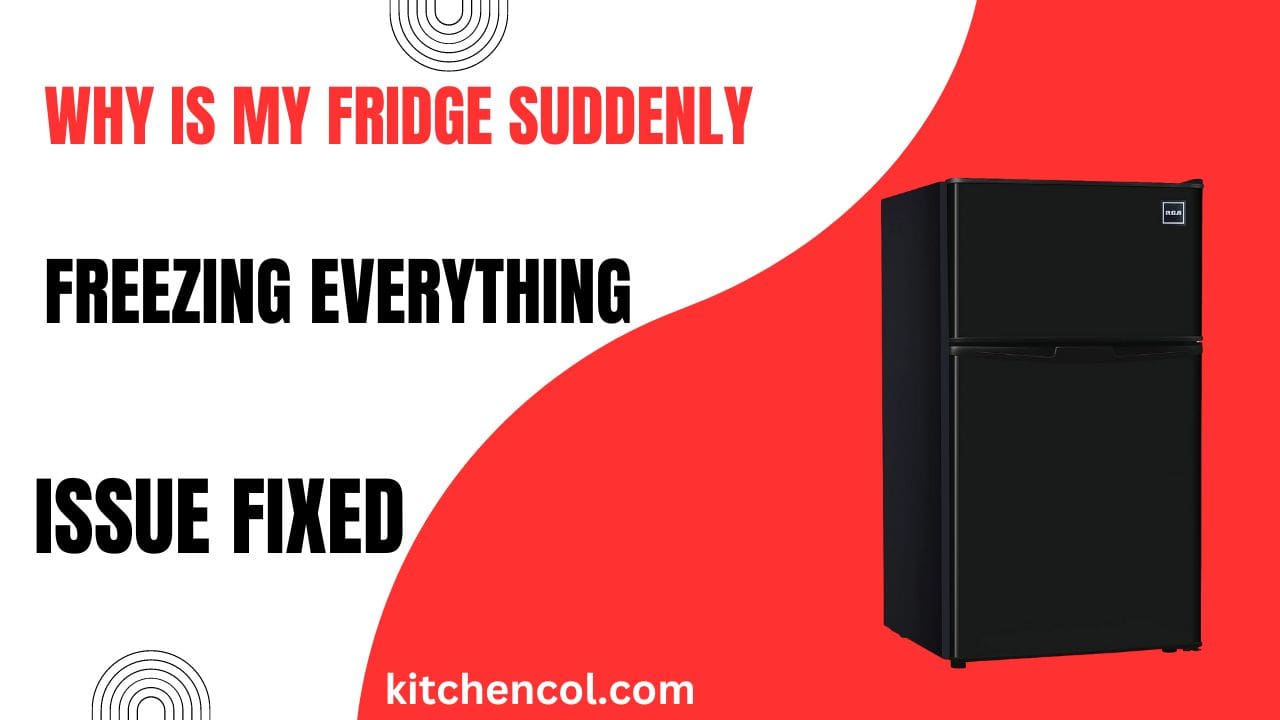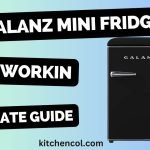Imagine opening your refrigerator, expecting to find your fresh produce and leftovers at the perfect temperature, only to discover everything has turned into a frozen mess. The sudden freezing of items in your fridge can be frustrating and perplexing, disrupting your daily routine and potentially leading to food waste. In this blog post, we delve into the puzzling issue of why your fridge might suddenly start freezing everything and provide valuable insights into the common causes behind this phenomenon.
Whether it’s a thermostat glitch, blocked air vents, or a more serious refrigerant leak, understanding these factors and their solutions will help you regain control over your refrigerator’s cooling prowess and ensure your food stays perfectly preserved. Let’s unlock the mysteries of fridge freezing and explore how to restore harmony to your kitchen appliance.
Understanding the Basics of Refrigeration
When it comes to the inner workings of your refrigerator, a basic understanding of refrigeration principles is key to unraveling the mystery behind sudden freezing.
At its core, refrigeration is a process that involves the transfer of heat to maintain a controlled and lower temperature within an enclosed space. Here’s a closer look at the fundamental concepts that keep your fridge humming and your food fresh:
The Refrigeration Cycle:
Refrigerators operate on a closed-loop system known as the refrigeration cycle. The compressor, condenser, expansion valve and evaporator are the cycle’s four primary parts.
As the refrigerant circulates through these components, it undergoes phase changes from a low-pressure gas to a high-pressure liquid and back again. This transformation allows the refrigerant to absorb heat from the interior of the fridge, effectively cooling its contents.
Temperature Control:
Temperature control is a critical aspect of refrigeration. Your fridge is equipped with a thermostat that monitors the internal temperature and triggers the compressor to start or stop based on the set temperature.

When the temperature rises above the desired level, the compressor kicks in to remove heat from the refrigerator’s interior. Conversely, when the temperature drops too low, the compressor halts, allowing the interior to warm up.
Insulation and Air Circulation:
Refrigerators are designed with proper insulation to minimize heat exchange between the interior and the external environment.
Additionally, strategically placed fans help circulate cold air evenly throughout the fridge’s compartments. This ensures that items placed inside receive uniform cooling, reducing the likelihood of freezing in some areas and warming in others.
Evaporator Coils and Heat Exchange:
The evaporator coils, typically located at the back of the fridge or within the freezer compartment, play a crucial role in cooling.
As the refrigerant evaporates within these coils, it absorbs heat from the surrounding air. This cooled air is then circulated throughout the refrigerator, maintaining a consistent temperature.
Pressure and Phase Changes:
The refrigeration cycle relies on the principles of pressure and phase changes to facilitate heat transfer. When the high-pressure liquid refrigerant expands through the expansion valve, it undergoes a rapid decrease in pressure, causing it to evaporate and absorb heat. As it flows back to the compressor, the refrigerant is compressed, raising its pressure and temperature, ready to repeat the cycle.
Understanding these basics of refrigeration gives us valuable insights into how your fridge operates to keep your food fresh. In the next section, we’ll delve into the common culprits that can disrupt this delicate balance and lead to the sudden freezing of items in your refrigerator.
Common Causes of a Fridge Freezing Everything
While your refrigerator’s intricate refrigeration system is designed to maintain a controlled environment, various factors can upset its delicate balance and lead to the sudden freezing of your groceries. Let’s explore some of the most common culprits behind this frustrating phenomenon:
Incorrect Temperature Settings:
- Thermostat Confusion: Accidental adjustments to the thermostat settings can inadvertently lower the temperature to freezing levels.
- Overcooling Consequences: Setting the temperature too low can cause the compressor to run excessively, resulting in items freezing.
Damaged Thermostat:
- Temperature Regulation Disruption: A malfunctioning thermostat may fail to signal the compressor to shut off, causing the fridge to continuously cool.
- Erratic Readings: Faulty sensors within the thermostat can provide inaccurate temperature readings, leading to inconsistent cooling.
Blocked Air Vents:
- Restricted Airflow: Obstructed air vents prevent proper circulation, causing cold air to accumulate in certain areas and freeze items.
- Uneven Cooling: Blocked vents can lead to temperature disparities between compartments, freezing some items while leaving others too warm.
Faulty Temperature Sensors:
- Inaccurate Feedback: Malfunctioning temperature sensors misinterpret the fridge’s internal climate, leading to improper cooling.
- Unresponsive Adjustments: The fridge may fail to respond to temperature adjustments if sensors are not functioning correctly.
Refrigerant Leak:
- Altered Cooling Efficiency: A refrigerant leak disrupts the refrigeration cycle, potentially causing erratic temperature fluctuations and freezing.
- Professional Intervention Required: Handling refrigerant issues demands specialized knowledge, making professional repair essential.
Identifying the root cause of your fridge’s sudden freezing behavior is crucial for effective troubleshooting and resolution. In the next section, we’ll delve into practical steps you can take to diagnose and address these issues, helping you restore your refrigerator to its optimal functioning and prevent future incidents of unwelcome frozen surprises.
Troubleshooting and Solutions
When faced with a refrigerator that’s turning your groceries into icicles, it’s important to methodically troubleshoot and implement solutions to rectify the issue. Here’s a step-by-step guide to help you diagnose and resolve the sudden freezing of items in your fridge:
Checking and Adjusting Temperature Settings:
- Locate the thermostat control panel within your refrigerator.
- Ensure the thermostat setting is at the recommended temperature for proper food preservation.
- Gradually adjust the temperature settings higher if they are too low, allowing the fridge to reach a balanced cooling level.
Inspecting and Clearing Air Vents:
- Carefully remove any items blocking the air vents within your fridge.
- Verify that there is unobstructed airflow between compartments and shelves.
- Gently clean the vents using a soft brush or cloth to remove dust and debris.
Testing and Replacing a Faulty Thermostat:
- Consult your refrigerator’s manual to locate the thermostat.
- Perform a temperature test by placing a thermometer inside the fridge for a few hours.
- If the temperature remains consistently too low, consider replacing the thermostat or contacting a professional for assistance.
Professional Help for Refrigerant Leaks:
- If you suspect a refrigerant leak, refrain from attempting to fix it yourself due to the potential hazards involved.
- Contact a certified appliance repair technician with expertise in handling refrigerant-related issues.
- The professional intervention will ensure the safe and effective resolution of the leak and restoration of proper cooling.
Regular Maintenance and Preventive Measures:
- Schedule routine maintenance to keep your fridge in optimal condition.
- Monitor the internal temperature periodically using a digital thermometer to catch any sudden deviations.
- Organize items in the fridge to avoid blocking air vents and promote even airflow.
- Maintain proper ventilation around the refrigerator to prevent overheating and interference with cooling mechanisms.
By following these troubleshooting steps and solutions, you can take proactive measures to address the sudden freezing of items in your fridge and prevent future occurrences.
However, if the issue persists or you are uncertain about diagnosing the problem, it’s always wise to consult a professional appliance repair service for accurate assessment and expert assistance.
Your refrigerator plays a crucial role in keeping your food fresh, so taking prompt action will ensure that it continues to serve its purpose effectively.
Preventive Measures to Avoid Future Freezing
Preventing the sudden freezing of items in your refrigerator involves a combination of mindful practices and regular maintenance. By taking proactive steps, you can ensure that your fridge operates smoothly and maintains an optimal temperature for preserving your food. Here are some preventive measures to help you avoid future freezing mishaps:
Regular Maintenance:
- Clean Condenser Coils: Dust and debris can accumulate on the condenser coil at the back or underneath the fridge, reducing cooling efficiency. Vacuum or gently brush these coils every few months.
- Check Door Seals: Damaged or loose door seals allow cold air to escape, leading to inconsistent temperatures. Inspect and replace seals if necessary to maintain an airtight seal.
Temperature Monitoring:
- Digital Thermometers: Invest in a digital thermometer to regularly monitor the temperature inside your fridge. This helps you detect any sudden fluctuations and take corrective action promptly.
Proper Food Placement:
- Allow Air Circulation: Arrange items in the fridge to allow for proper airflow. Avoid overcrowding shelves and ensure there’s space around items for cold air to circulate.
- Elevate Delicate Items: Place delicate or temperature-sensitive items away from the coldest parts of the fridge to prevent freezing.
Avoiding Blockage:
- Keep Vents Clear: Regularly check and clear air vents to ensure consistent airflow between compartments.
- Smart Storage: Be cautious when placing items near vents or fans, as this can disrupt proper air circulation.
Regular Temperature Checks:
- Periodically verify that your fridge’s internal temperature matches the desired setting using a thermometer.
- Adjust as Needed: If you notice temperature discrepancies, adjust the thermostat settings accordingly to maintain the ideal cooling level.
Professional Maintenance:
- Schedule Professional Inspections: Arrange for a professional technician to inspect and service your refrigerator annually or as recommended by the manufacturer.
- Refrigerant Checks: A professional can identify and address any potential refrigerant leaks, ensuring the safety and efficiency of your appliance.
Power Interruptions:
- Minimize Openings: During power outages, avoid opening the fridge unnecessarily to retain cold air.
- Use Thermometers: Place ice packs or frozen water bottles in the freezer to serve as indicators of temperature fluctuations during outages.
By incorporating these preventive measures into your routine, you can significantly reduce the risk of your refrigerator suddenly freezing everything inside.
A well-maintained fridge not only safeguards your food but also extends the lifespan of your appliance, ultimately saving you money and preventing potential inconveniences down the line.
Remember, a little proactive care goes a long way in ensuring the smooth operation of your refrigerator and maintaining the freshness of your groceries.
Also Read: How to Fix Black and Decker Mini Fridge Reset Button
Conclusion
In the quest to understand and conquer the sudden freezing of our refrigerator’s contents, we’ve unveiled the intricate dance of refrigeration and the critical role of temperature control, air circulation, and component health.
Armed with practical troubleshooting steps, we’ve learned to navigate thermostat settings, unblocking air vents, and address refrigerant leaks through professional intervention. However, the true key to preventing future freezing lies in proactive measures.
Regular maintenance, temperature monitoring, strategic food placement, and professional inspections form a shield against unwanted cooling extremes.
Our journey through refrigeration intricacies has not only empowered us to rescue our groceries but has also highlighted the symbiotic relationship between knowledge and appliance care.
By embracing these preventive actions, we ensure that our refrigerator stands as a steadfast guardian of freshness, preserving both food and efficiency in our daily lives.

My name is Manan Bukhari and I am an expert in reviewing kitchen products for years. I have a passion for testing multiple gadgets especially related to home & kitchen. I love to spend my free time in resolving issues if I face some in any of my daily use things. I have fixed multiple gadgets of my home on my own without any assistance and that thing gave me confidence to make a blog on troubleshooting of items that are for daily use to assist you folks. Even my wife praises me for having such talent. I always explore new machines on my own because this thing fascinates me.



